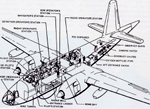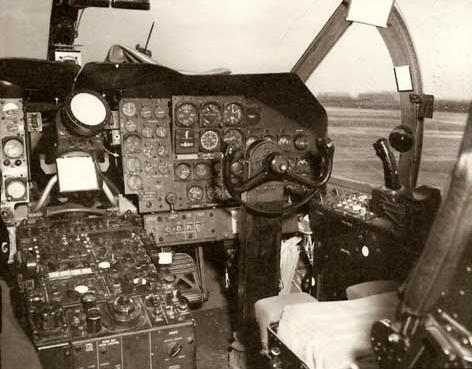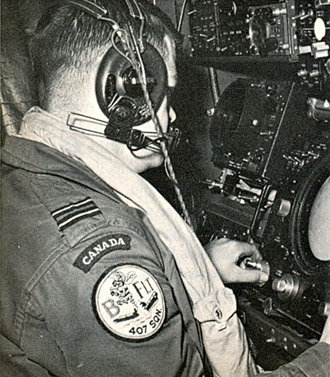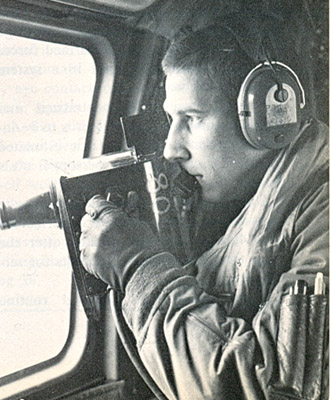 |
This cutaway shows the crew positions described in the table above. Click to enlarge. (DND cutaway from the collection of Ernie Cable). |
The crew positions for the Neptune followed the arrangement in the table below. All Tactical compartment crew faced the starboard side. Crew count was variable. In some cases 9 crew were standard complement. Jim Loring remembers a crew of 11 as the normal complement for 407 Squadron: 2 Pilots, 2 Navigators, 1 Flight Engineer, and 5 to 6 Radio operators. On routine transits, the Radio, Radar and Navigation positions were manned. In tactical situations there were more crew - Nose Observer, Radio, Radar, Acoustics/MAD, ESM, and ASW . The ASW position was at the rear of the aircraft where sonobuoys, charges, and smokes were loaded for use. The Radio Operators were the "Jack-of-all trades" type crew member.
| PORT | ^ FORWARD^ | STARBOARD |
| Nose Observer | ||
| Pilot | Copilot | |
| Flight Engineer [1] | ||
| Radar | ||
| Sonobuoy Detection | ||
| Navigator | ||
| ECM [2] | ||
| WING SPAR---WING SPAR---WING SPAR---WING SPAR | ||
| Two 'crash positions' [3] | Radio operator [4] | |
| ---Down steps--- | ||
| Crew galley | ||
| Port Lookout | Starboard Lookout | |
NOTES:[1] The Flight Engineer sat in a jump seat just behind and between the pilot and co-pilot.
[2] The position was jammed against the forward side of the main spar. After the Neptune was retired, the name of the function changed to ESM.
[3] Folding headrests were against the wing spar.
[4] The Radio Operator normally faced Starboard with the radio equipment mounted in a rack which adjoined the starboard side of the fuselage. His chair could be swivelled from starboard to aft depending on whether he was using the work surface or tuning/operating the radio equipment. Also, the Radio Ops chair would be rotated to face aft during take-offs and landings. This would allow the seat back to absorb any "G" forces in the event of sudden deceleration.
 |
This cutaway shows the crew positions described in the table above. Click to enlarge. (DND cutaway from the collection of Ernie Cable). |
On routine transits the navigator position was also manned. In "Tactical" situations the junior navigator manned the "Nose Observer" station. The senior navigator manned the navigator station and not only was he responsible for navigating the aircraft, but as the "Tactical Coordinator" he became the heart of the crew by directing all search, localization and attack tactics. During the flight the two navigators would exchange positions thus giving the senior navigator a "rest" in the nose and the junior navigator experience directing the crew through the tactical evolutions under the supervision of the senior navigator in the nose.
 |
| Pilot's position. Note the AN/APS-20 repeater scope in the upper right corner. American P2V7's had a tactical repeater display instead of the reperater scope.. |
 |
| Co-pilot's seat. The joystick to the right of the yoke was used to train the searchlight in azimuth and elevation. |
| Both are RCAF photos from the collection of Dave Fletcher. |
 |
| Operating the APS-20 radar. (Photo by Cpl. James Cockrane, RCAF from Sentinel Magazine, October 1966). |
 |
| This camera records surface vessels for later identification. It is likely a 7" Hultcher. (Photo by Cpl. James Cockrane, RCAF from Sentinel Magazine, October 1966). |
Credits and References:1) Sentinel Magazine October 1966 "Hunting the Phantoms of the Sea". Photos by Cp. James Cockrane, RCAF.
2) Sentinel Magazine July-Aug 1968 "King Neptune".
3) David C. Fletcher <dcf(at)mars.ark.com>
4) Ernest Cable - Associate Air Force Historian and Shearwater Aviation Museum Historian <erncar(at)ns.sympatico.ca>
Sept 19/09